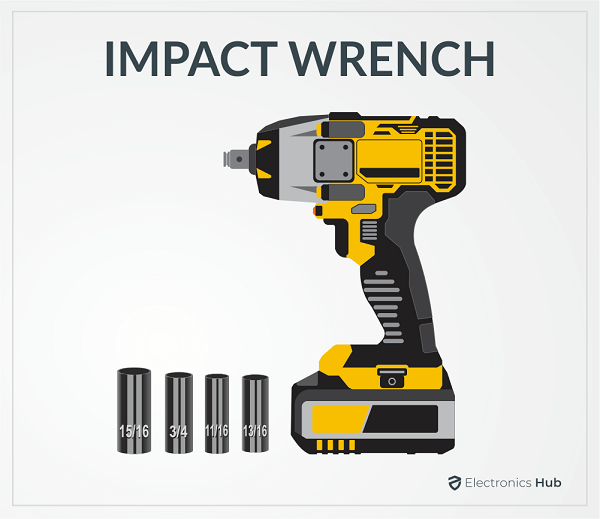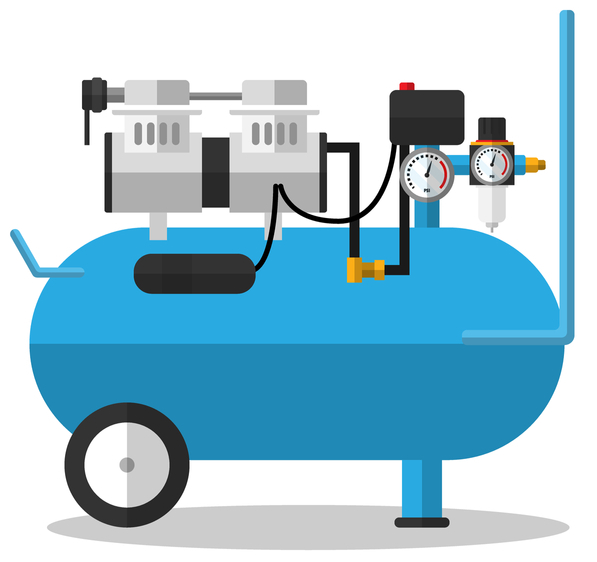Impact Wrenches are the workhorses in the automotive industry. Be it the assembling plants or garages/workshops, you can see dozens of wrenches in action. While there are powerful and reliable Electric Impact Wrenches, Pneumatic Impact Wrenches are the preferred choice in many workshops. And if it is a pneumatic tool, then you also need an air compressor to “power” the tool. If you are planning to buy an air compressor for your garage/workshop, you might be wondering “What Size Air Compressor Do I Need for Impact Wrench?”.
In this guide, we will see all the factors you need to consider when picking an air compressor to run an impact wrench. After that, we will see how the size of the impact wrench or how often you use it affects the choice of air compressor.
Finally, we will see some generic answers to the important question: What Size Air Compressor Do I Need for Impact Wrench?
Outline
ToggleA Brief Note on Impact Wrenches and Air Compressors

A typical application of the Impact Wrench is to remove or fit lug nuts on a car to remove or replace tires. These lug nuts often need a lot of torque to loosen or tighten them and Impact Wrenches can deliver that.
While there are electric impact wrenches, automotive workshops prefer Air Impact Wrenches (among other air tools). Some reasons for this choice are:
- Air Impact Wrenches are more lightweight and powerful than their electric counterparts.
- As there is no electric motor, there is no chance of sparks.
- They are not a shock hazard
An Air Impact Wrench can rotate in clockwise as well as counter-clockwise directions. A valve in the tool controls the amount of torque it applies.
Speaking of torque, an impact wrench’s torque is dependent on the tool as well as the pressure of air fed by the air compressor.
Air Tools such as Impact Wrenches, Drills, Grinders, etc. operate using high-pressure compressed air. The system usually consists of an air compressor, pressure regulator, air hose, and different types of air compressor fittings.
An electric motor compresses air and stores it in a metal tank. With the help of a pressure regulator, you can control the amount of air pressure the tank outputs.
What Size Air Compressor Do I Need for Impact Wrench?
Now, let us focus on the main question in the discussion; what size air compressor do I need for impact wrench? To answer this question, we need to take a look at a couple of important things.
The first one is the drive size of the Impact Wrench. Air Impact Wrenches are available in 4 common drive sizes:
- 3/8”
- 1/2″
- 3/4″
- 1”
Impact Wrenches with different drive sizes have different airflow requirements. Speaking of airflow, we measure it in cubic feet per minute, or CFM. Most air tools require a certain CFM of air at 90 psi pressure while running free.
Here are the typical CFM ratings for different drive sizes.
- 3/8” – 3 CFM @ 90 psi
- 1/2” – 4-5 CFM @ 90 psi
- 1” – 8-10 CFM @ 90 psi
Air Flow of Air Compressor
So, it is important that you check the size of your impact wrench and its minimum CFM ratings recommended by the manufacturer.
Note that these are the minimum CFM values. The air compressor you choose must deliver at least this amount of airflow at 90 psi pressure for the impact wrench to run freely.
This means the air compressor must have a slightly higher airflow than this value. But how much more?
As a simple rule of thumb, the airflow from the air compressor must be at least 3/2 times the minimum requirement of the impact wrench.
For example, a 1/2″ drive Impact wrench usually has a requirement of about 5 CFM airflow at 90 psi. So, the airflow rating of the air compressor at 90 psi should be 3/2 * 5 = 7.5 CFM.
Size of Air Compressor’s Tank
The size of the air compressor’s tank determines how long you can use the impact wrench continuously without switching on the motor.
You can find air compressor tanks that can hold 80 – 100 gallons of air. At the same time, there are also smaller tank sizes such as 6 gallons and 16 gallons.
So, what’s the optimum air compressor tank size? This depends on how long you want to use the air tool but as a rule of thumb, we usually recommend an air compressor tank size of at least 5 to 6 times the airflow requirement of the tool.
For example, if the impact wrench has an airflow requirement of 5 CFM, then the tank size of the air compressor must be at least 25 to 30 liters (6 – 8 gallons).
In this case, you can expect the impact wrench to operate for about an hour or an hour and a half.
Note that these are just recommendations. If you run multiple tools and use air tools for a lot of jobs, then a larger tank size will definitely be beneficial.
What Other Things Do You Need to Consider?
Let us now see all the important things you need to consider while purchasing an air compressor.
- Size of Air Tool (Impact Wrench)
- How Long Do You Intend to Use the Tool?
- How Many Tools Do You Use at the Same Time?
- Garage or Workshop Area
- Type of Work
Size of Air Tool (Impact Wrench)
As we mentioned earlier, the drive size of the air tool, which is an Impact Wrench in this discussion, plays an important role in determining the air compressor you need.
Impact Wrenches with smaller drive sizes (3/8” or 1/2″) need less airflow than tools with larger drive sizes (3/4” or 1”).
We measure the airflow in CFM (cubic feet per minute). Check the CFM ratings of the impact wrench as well as the air compressor.
How Long Do You Intend to Use the Tool?
If you want to use the Impact Wrench for a continuously long duration, then you need an air compressor that can hold a large volume of air.
So, the tank size of the air compressor becomes crucial. You can get air compressors with small tanks (2 gallons), medium size tanks (6 – 16 gallons), and large tanks (more than 30 gallons).
How Many Tools Do You Use at the Same Time?
Another important factor that impacts your buying decision of an air compressor is the number of air tools you use simultaneously. If you own or operate a large garage or workshop where you have a crew that works on several vehicles at the same time, then it is better to invest in a large industrial air compressor.
They have the airflow capacity to feed multiple tools and also a larger tank that can hold significantly large volumes of air.
Garage or Workshop Area
Air compressors and air tools are loud machines. Irrespective of the size of the garage, we recommend you place the air compressor far away from the main work area and run hoses through the workshop.
If you have a small garage, then consider building a tiny shed outside the garage to house the air compressor so that we keep its noise to a minimum level.
Another important thing is the size of the air compressor. If you have a large workshop with separate space to put the air compressor, then you can get away with a large-size air compressor.
But for small workshops or garages with already congested space, a small air compressor is a better choice.
Type of Work
Automotive and construction are the two main “types” of work that use air tools. For smaller jobs such as painting or drilling, you don’t need a super powerful air compressor.
But for using high torque air tools such as impact wrenches, hammers, etc. you need a strong air compressor.
Conclusion
Air Impact Wrenches are very important tools in automotive garages and workshops. Be it in small garages or large workshops, impact wrenches are a necessity to finish the job easily, efficiently, and effortlessly.
But if you are wondering, what size air compressor do I need for impact wrench, then we covered this in this guide. We saw some basics of impact wrenches and air compressors.
After that, we saw the factors that determine the size of the air compressor. Finally, we gave a couple of simple ways to calculate the right air compressor you need for “powering” an impact wrench.


